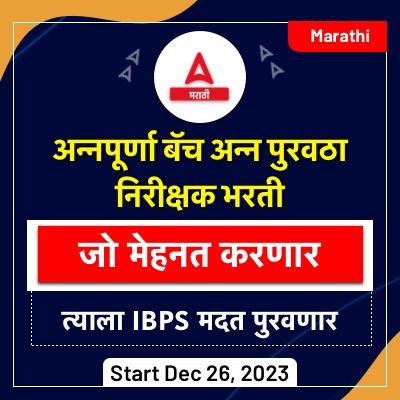
अर्थशास्त्र दैनिक क्विझ मराठीमध्ये: 26 मे 2021
महाराष्ट्र राज्य लोकसेवा आयोग दरवर्षी वेगवेगळ्या परीक्षे मार्फत हजारो विद्यार्थ्यांची भरती करून घेते MPSC State Service, MPSC Group B, MPSC Group C, Saral Seva Bharati, Talathi, UPSC, SSC, RRB अशा अनेक परीक्षांमार्फत हजारो जागांची भरती दरवर्षी निघते ज्यात लाखो इच्छुक हजार किंवा त्याहूनही कमी जागांसाठी अर्ज करतात. आपण एमपीएससी आणि इतर परीक्षाची तयारी करत असाल तर आपल्याला क्विझ देण्याचे महत्त्व माहित असलेच पाहिजे. बर्याच विद्यार्थ्यांना अभ्यासाचे पुरेसे तास दिले जात असतानाही त्यांना या परीक्षांची पूर्तताही करता आली नाही कारण ते त्यांचे परीक्षण वेळेवर पूर्ण करू शकत नाहीत आणि संशोधन करण्याचा उत्तम मार्ग म्हणजे त्या संबंधित विषयाची किंवा विषयाची क्विझ देणे कारण आपण या मार्गाने कव्हर करू शकता कमी वेळात जास्तीत जास्त विषय. आम्हाला Add 247 मराठी येथे चांगल्या अभ्यास सामग्रीचे मूल्य समजले आहे आणि म्हणूनच आम्ही सर्व विषयांसाठी आपल्याला क्विझ प्रदान करीत आहोत. दैनिक क्विझ देऊन तुम्ही तुमच्या तयारीची पातळी तपासू शकता.
चालू घडामोडी, भूगोल, अर्थशास्त्र, पर्यावरण, सामान्य विज्ञान, इतिहास, पॉलिटी अशा सर्व स्पर्धात्मक सामान्य अभ्यास विषयांमध्ये अर्थशास्त्राचाही महत्वाचा वाटा आहे. तर चला अर्थशास्त्र बद्दल तुमची तयारी तपासण्यासाठी खालील 26 मे 2021 ची अर्थशास्त्राची दैनिक क्विझ पहा.
Q1. अलीकडे भारत सरकारने खालीलपैकी कोणत्या देशातील गुलफिल्हू बंदर आणि थिलाफुशी औद्योगिक क्षेत्रासाठी स्वतंत्रपणे 100 दशलक्ष डॉलर्स अनुदान दिले आहे-
(a) सेशल्स
(b) मादागास्कर
(c) नायजेरिया
(d) मालदीव
Q2. बाँडच्या उत्पन्नासंदर्भात पुढील विधानांचा विचार करा.
1. बाँडची किंमत जसजशी वाढत जाते तसतसे उत्पन्नही वाढते
2. उत्पादनातील वाढ नियंत्रित करण्यासाठी आरबीआयने दुय्यम बाजार सरकारचा सुरक्षा संपादन कार्यक्रम किंवा जीएसएपी जाहीर केला
वर दिलेले कोणते विधान/विधाने बरोबर आहे/ आहेत?
(a) फक्त 1
(b) फक्त 2
(c) दोन्ही 1 आणि 2
(d) 1 किंवा 2 देखील नाही
Q3. राज्य विकास कर्ज (एसडीएल) संबंधित खालील विधानांचा विचार करा.
1. वित्त विभाग मार्केटमधील राज्य विकास कर्जाच्या सिक्युरिटीजची मुदत सुलभ करते.
2. एसडीएलच्या डीफॉल्ट बाबतीत आरबीआयच्या खात्यात असलेल्या राज्यांना केंद्र सरकारच्या वाटपामधून परतफेड करण्याचे अधिकार आरबीआयकडे आहेत
वर दिलेले कोणते विधान/विधाने बरोबर आहे/ आहेत?
(a) फक्त 1
(b) फक्त 2
(c) दोन्ही 1 आणि 2
(d) 1 किंवा 2 देखील नाही
Q4. ट्रेझरी बिले (टी-बिल्स) संबंधित खालील विधानांचा विचार करा.
1. ट्रेझरी बिले सर्वप्रथम 1917 मध्ये भारतात देण्यात आली होती.
2. आरबीआयने केलेल्या टी-बिलांच्या लिलावात लोक भाग घेऊ शकत नाहीत
3. ट्रेझरी बिलांचा फायदा इतर बाजाराच्या साधनांपेक्षा जास्त आहे कारण त्यांच्याशी संबंधित शून्य जोखीम वजनामुळे आणि आंतरराष्ट्रीय बाजारपेठेतील अशाच मुद्रा बाजार उपकरणांच्या तुलनेत जास्त परतावा मिळतो.
वर दिलेले कोणते विधान/विधाने बरोबर आहे/ आहेत?
(a) फक्त 1
(b) 1 आणि 2
(c) 2 आणि 3
(d) 1,2,3
Q5. पुढीलपैकी कोणते टी-बिलाचे संप्रदाय असू शकत नाही?
(a) 15 दिवस
(b) 91 दिवस
(c) 182 दिवस
(d) 356 दिवस
Q6. कॅश मॅनेजमेंट बिलेसंदर्भात खालील विधानांचा विचार करा
1. भारत सरकारच्या रोख रकमेतील तात्पुरती जुळणी करण्यासाठी आरबीआयने कॅश मॅनेजमेंट बिल्स (सीएमबी) म्हणून ओळखले जाणारे एक अल्पकालीन साधन सादर केले.
2. सीएमबीकडे टी-बिल्सचे सामान्य वैशिष्ट्य असते परंतु ते 1 वर्षापेक्षा कमी कालावधीच्या मुदतीसाठी दिले जातात
वर दिलेले कोणते विधान/विधाने बरोबर आहे/ आहेत?
(a) फक्त 1
(b) फक्त 2
(c) दोन्ही 1 आणि 2
(d) 1 किंवा 2 देखील नाही
Q7. सॉवरेन गोल्ड बाँड (एसजीबी) योजनेसंदर्भात पुढील विधानांचा विचार करा
1. हे रोखे 1 ग्रॅम सोन्याच्या संप्रदायात जारी केले जातात आणि त्यास व्यक्तींसाठी जास्तीत जास्त 5 किलोच्या मर्यादेनुसार गुणाकार दिले जातात.
2. बँकांकडून घेतलेल्या कर्जासाठी ते संपार्श्विक म्हणून वापरले जाऊ शकतात
3. एसजीबी विमोचन बाबतीत, एखाद्या व्यक्तीस लागू असलेल्या भांडवली नफा करात सूट दिली जाते.
वर दिलेले कोणते विधान/विधाने बरोबर आहे/ आहेत?
(a) 1 आणि 2
(b) फक्त 2
(c) 2 आणि 3
(d) 1, 2, 3
Q8. पुढील विधानांचा विचार करा
1. रोखे उत्पन्न हे गुंतवणूकदाराला त्या रोखेवर किंवा विशिष्ट सरकारी सुरक्षिततेवर मिळते
2. जेव्हा रोखेचे उत्पन्न वाढते तेव्हा त्याचा परिणाम कर्जात इक्विटींमधून भांडवलाचा प्रवाह होतो.
वर दिलेले कोणते विधान/विधाने बरोबर आहे/ आहेत?
(a) फक्त 1
(b) फक्त 2
(c) दोन्ही 1 आणि 2
(d) 1 किंवा 2 देखील नाही
Q9. आरबीआयनुसार टी-बिले _________ च्या किमान मूल्यासह जारी केली जातात आणि ती तेथे वाढतात-
(a) 10000
(b) 5000
(c) 20000
(d) 25000
Q10. पुढील विधानांचा विचार करा
1. कॉल मनी म्हणजे अल्प मुदतीच्या वित्त मागणीनुसार परतफेड करता येते, एक दिवस ते पंधरा दिवसांच्या मुदतीसाठी, फक्त आंतर-बँक व्यवहारासाठी वापरला जातो.
2. कॉल मनी रेट कर्जावरील कॉल मनी रेट व्याज हा अत्यंत अस्थिर दर आहे जो दररोज आणि कधीकधी तास- तासाने बदलत असतो.
वर दिलेले कोणते विधान/विधाने बरोबर आहे/ आहेत?
(a) फक्त 1
(b) फक्त 2
(c) दोन्ही 1 आणि 2
(d) 1 किंवा 2 देखील नाही
महाराष्ट्र राज्यातील सर्व स्पर्धा परीक्षांचे मोफत अभ्यास साहित्य
YouTube channel- Adda247 Marathi
App- Adda247 (मराठी भाषा)
Use Coupon code: HAPPY
आणि मिळवा 75% डिस्काउंट
आता तुमच्या घरी लाइव्ह वर्ग मराठीत उपलब्ध आहेत
केवळ सरावच परीक्षेत चांगले गुण मिळण्यास मदत करू शकतो
SBI लिपिक फाउंडेशन बॅच | द्विभाषिक
Solutions
S1.Ans.(d)
Sol.
A team from the EXIM Bank of India on Monday signed a Line of Credit Agreement for USD 400 million to fund the Greater Male Connectivity Project (GMCP).
This will be the single-largest infrastructure project in the Maldives and will link Male with Villingili, Gulhifalhu, and Thilafushi islands.
Source: https://indianexpress.com/article/india/greater-maldives-connectivity-project-6721899/
S2.Ans.(b)
Sol.
If one has to explain in simple terms, bond yield means the returns an investor will derive by investing in the bond. The mathematical formula for calculating yield is the annual coupon rate divided by the current market price of the bond. Therefore, there is an inverse relationship between the yield and price of the bond. As the price of the bond goes up, the yield falls; and as the price of the bond goes down, the yield goes up.
In India, the yield of 10-year government securities (G-Sec) is considered the benchmark and shows the overall interest rate scenario. This year, G-Sec yields have gone up compared to the previous year after the Centre announced its increased borrowing programs in Budget 2021. As government borrowing goes up, the supply of bonds in the market goes up, putting pressure on prices. The government has announced a borrowing of ₹12 trillion in FY22.
To control the rise in yields, the RBI has announced a secondary market government security acquisition program or GSAP, wherein it will buy government bonds worth ₹1 trillion from the secondary market in Q1 FY22.
Source: https://www.livemint.com/money/personal-finance/what-does-a-rise-in-bond-yield-mean-11618165006661.html
S3.Ans.(b)
Sol.
State Development Loans (SDLs) are market borrowings by state governments. RBI coordinates the actual process of selling these securities. Each state is allowed to issue securities up to a certain limit each year. Generally, the coupon rates on State Development Loans are higher than those of government securities (popularly called G-secs) of the same maturity. This shows that the central government is considered more creditworthy than state governments. SDLs are, however, considered safer than loans by state government undertakings because RBI has the power to make repayments out of central government allocation to states which lie in an account with RBI. SDLs are normally sold through an auction process, just like central government securities. SDLs too are traded in the secondary market but are much less liquid than central G-secs.
Source: https://economictimes.indiatimes.com/news/economy/finance/et-in-classroom-state-development-loans/articleshow/5740842.cms?from=mdr
S4.Ans.(a)
Sol.
Treasury bills were first issued in India in 1917. They are issued via auctions conducted by the Reserve Bank of India (RBI) at regular intervals. Individuals, trusts, institutions, and banks can purchase T-Bills. But they are usually held by financial institutions. They have a very important role in the financial market beyond investment instruments. Banks give treasury bills to the RBI to get money under repo. Similarly, they can also keep it to fulfill their Statutory Liquid Ratio (SLR) requirements.
The primary disadvantage of government treasury securities is that they are known to generate relatively lower returns when compared to standard stock market investment tools. Treasury bills are zero-coupon securities, issued at a discount to investors. Hence, total returns generated by such instruments remain constant through the tenure of bonds, irrespective of economic conditions and business cycle fluctuations.
It comes in contrast to the stock market, wherein market variations heavily influence returns generated by both equity and debt tools. Consequently, in the event of an upswing in the stock market, the yield rate of associated tools is significantly higher than the capital gains generated through G-Sec investments
Treasury bills are auctioned by the RBI every week through non-competitive bidding, thereby allowing retail and small-scale investors to partake in such bids without having to quote the yield rate or price. It increases the exposure of amateur investors to the government securities market, thereby creating higher cash flows to the capital market. Such tools act as a liability to the Indian government as they need to be repaid within the stipulated date. Hence, individuals enjoy comprehensive security on the total funds invested as they are backed by the highest authority in the country, and have to be paid even during an economic crisis.
Source : https://groww.in/p/treasury-bills/
https://www.business-standard.com/about/what-is-treasury-bills
S5.Ans.(a)
Sol.
The distinction between different treasury bill types is made based on their tenure, as enumerated below:
14-day treasury bill
91-day treasury bill
182-day treasury bill
364-day treasury bill
S6.Ans.(a)
Sol.
Cash Management Bills (CMBs)
In 2010, the Government of India, in consultation with RBI introduced a new short-term instrument, known as Cash Management Bills (CMBs), to meet the temporary mismatches in the cash flow of the Government of India. The CMBs have the generic character of T-bills but are issued for maturities less than 91 days.
Source: https://m.rbi.org.in/Scripts/FAQView.aspx?Id=79
S7.Ans.(c)
Sol.
Context: The Reserve Bank of India (RBI) has announced a plan to sell sovereign gold bonds (SGBs) — government securities denominated in grams of gold — in six phases until September 3.
What are the minimum and maximum limits for investment?
The bonds are issued in denominations of 1 gram of gold and in multiples thereof. The minimum investment will be 1 gram, with a maximum limit of subscription of 4 kg for individuals, 4 kg for Hindu Undivided Family (HUF), and 20 kg for trusts and similar entities notified by the government from time to time per fiscal year (April–March).
They can be used as collateral for loans from banks, financial institutions, and non-banking financial companies (NBFC).
The interest on Sovereign Gold Bonds is taxable as per the provisions of the IT Act, 1961. In the case of SGB redemption, the capital gains tax applicable to an individual is exempted.
https://cleartax.in/s/sovereign-gold-bonds
S8.Ans.(a)
Sol.
Bonds are the loans that one makes to a corporation or government. Bond yield is a return an investor gets on that bond or on particular government security. The major factors affecting the yield are the monetary policy of the Reserve Bank of India, especially the course of interest rates, the fiscal position of the government, global markets, economy, and inflation. A fall in interest rates makes bond prices rise, and bond yields fall and rising interest rates cause bond prices to fall, and bond yields to rise.
Bond yields are inversely proportional to equity returns, when bond yields decline, equity markets tend to outperform, and when yields rise, equity markets tend to fall. Traditionally when bond yields go up, investors start reallocating investments away from equities into bonds
Bonds yields play an important role in FPI flow. When bond yields rise, FPI’s move out of the equity markets. When bond yield goes up, it results in capital outflows from equities in debt.
A higher return in treasury bonds leads investors to move their asset allocation from more risky equity markets to Treasury bonds which is the safest investment instrument.
Source: https://taxguru.in/finance/increase-bond-yields-effect-economy-stock-market.html
S9.Ans.(d)
Sol.
T-bills are available for a minimum amount of Rs.25,000 and in multiples of Rs. 25,000. T-bills are issued at a discount and are redeemed at par.
Source: https://www.rbi.org.in/scripts/PublicationsView.aspx?id=1850
https://ncert.nic.in/ncerts/l/lebs210.pdf
S10.Ans.(c)
Sol.
Call Money: Call money is short-term finance repayable on demand, with a maturity period of one day to fifteen days, used for inter-bank transactions. Commercial banks have to maintain a minimum cash balance known as the cash reserve ratio. The Reserve Bank of India changes the cash reserve ratio from time to time which in turn affects the number of funds available to be given as loans by commercial banks. Call money is a method by which banks borrow from each other to be able to maintain the cash reserve ratio. The interest rate paid on call money loans is known as the call rate. It is a highly volatile rate that varies from day-to-day and sometimes even from hour-to-hour
Source: https://ncert.nic.in/ncerts/l/lebs210.pdf










